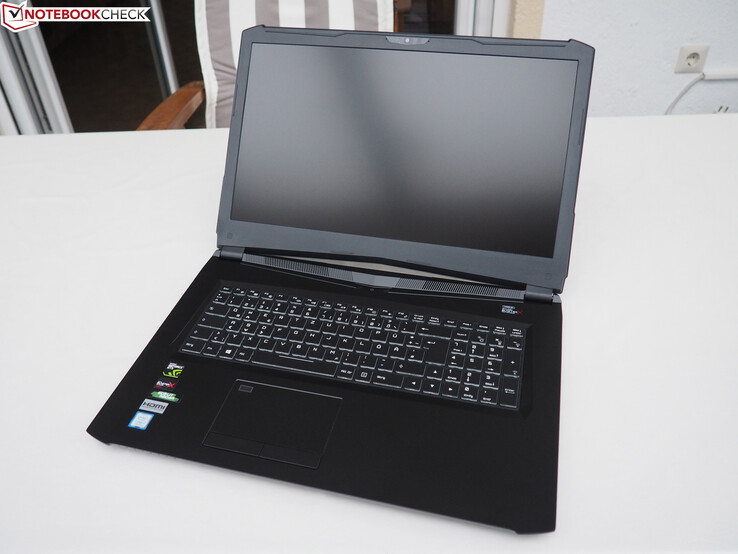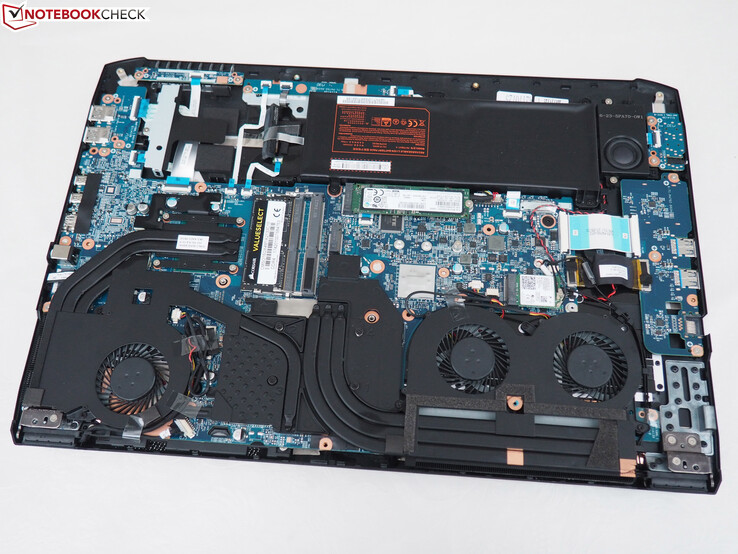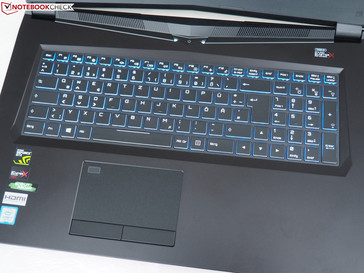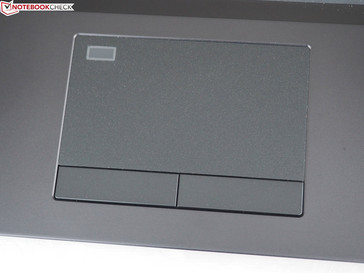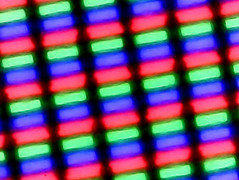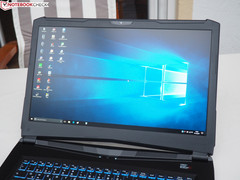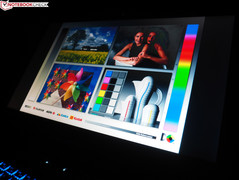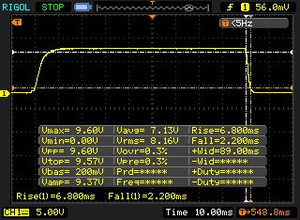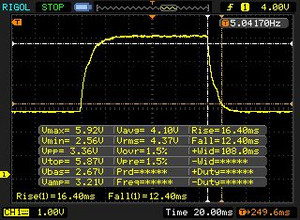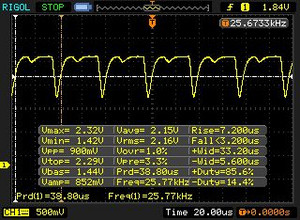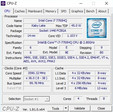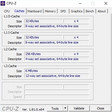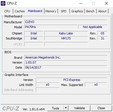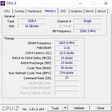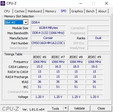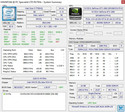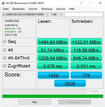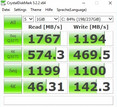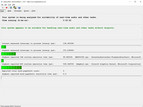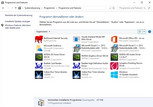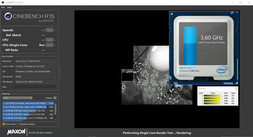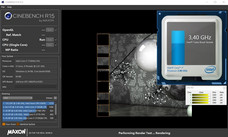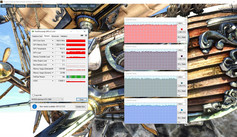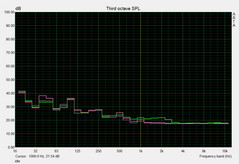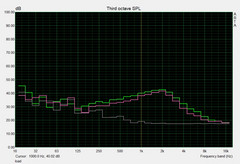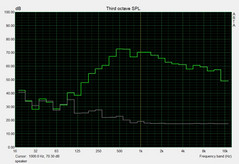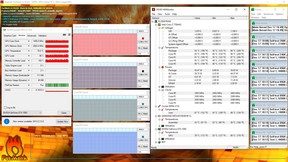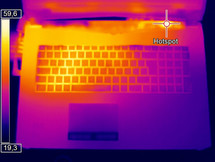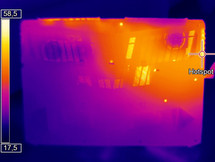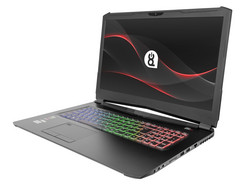PC Specialist Defiance IV (i7-7700HQ, GTX 1060, Full HD) Laptop Review

If you are looking for a high-end notebook that can be configured individually, the online store pcspecialist.co.uk is the right place for you. The manufacturer offers compact 14 and 15-inch devices as well as several 17-inch models.
The Defiance IV is available from £1150 (~$1537, at the time of writing - Dec 21, 2017) and its basic configuration offers a quad-core processor from Intel's Kaby Lake series and a 120-Hz TN panel. It can also be equipped with 4 - 32 GB of DDR4 RAM and either a GeForce GTX 1060 or GTX 1070. There are a lot of optional storage devices, as the Defiance IV not only has a 2.5-inch drive bay but also has two modern M.2 slots, one of which supports PCIe.
The power supply, thermal paste, wireless module, operating system and keyboard language can also be chosen by the user. We will not go into details about the many peripheral devices and accessories that can be purchased with the notebook. Our test unit, which is powered by a GeForce GTX 1060, 16 GB of RAM and a 256-GB SSD with NVMe technology, costs about £1500 (~$2005) at the time of writing.
There is a lot of competition for 17-inch notebooks in the gaming segment. We will use suitable devices from the (mobile) Top 10 list as comparison devices for this review. These include the MSI GS73VR 7RG (GTX 1070 Max-Q), the Acer V17 Nitro (GTX 1060) and the Razer Blade Pro (GTX 1060). The list is completed by the significantly more powerful Medion Erazer X7857 (i7-7820HK/GTX 1070), which is based on an almost identical case.
Please note: This device is not available in the US at the time of writing.
Case
Unlike the recently tested Proteus V, the case of the Defiance IV comes from the well-known barebone manufacturer Clevo. The 17-inch case is made almost entirely of aluminum, which promises high quality and good stability. Unfortunately, the latter is only true for the base unit: The display cover could be a lot more stable and warp-resistant despite its metal surface.
Apart from that, the case gave a great impression. We have nothing to criticize about the workmanship, for example. The design, as always, is a matter of taste. The shape and form is quite modern considering it is a Clevo case, but it still remains simple and straightforward. The same case (PA71HP6) is used in a slightly altered form for the Medion Erazer X7857, which means that the two devices can be compared with each other easily.
Talking of comparison: While many 17-inch gaming devices are rather bulky, the Defiance IV is quite slim with a height of 2.5 cm (~0.98 in) - only the MSI GS73VR 7RG (19.6 mm / 0.77 in) and the Razer Blade Pro (22.5 mm / 0.88 in) are slimmer. The weight is average at 3.0 kg (~ 6.6 lbs). This is a little too heavy to carry about regularly, so users who travel a lot might want to choose a lighter 15-inch device.
Connectivity
Ports
Apart from the missing Thunderbolt 3 port, the Defiance IV has a very good port selection. It offers a total of five USB 3.0 / 3.1 gen 1 ports (4x Type-A, 1x Type-C), which is just as generous for a gaming notebook as the three digital image output connectors (2x Mini-DisplayPort, 1x HDMI) and three audio jacks (headphones, microphone, S/PDIF). Last but not least, the device has an RJ45 port, a card reader and a Kensington lock connector.
The distribution of the ports is not quite as pleasing. Many ports are placed towards the front of the two sides, which can make it difficult to use a mouse without colliding with connected cables. We would have preferred a stronger focus on the back for port positioning.
SD card reader
The card reader not only supports the usual formats (SD, Mini-SD, SDHC and SDXC) but also supports the more unusual MMC and RSMMC versions. We would also like to compliment the Defiance IV on its first-class performance in this area. Only the MSI GS73VR 7RG can keep up with a sequential read rate of 207 MB/s, and 179 MB/s when transferring photos (which was measured with our reference card from Toshiba). Most gaming notebooks only manage USB 3.0 speeds (about 100 MB/s) or USB 2.0 speeds (about 30 MB/s).
| SD Card Reader | |
| average JPG Copy Test (av. of 3 runs) | |
| MSI GS73VR 7RG (Toshiba Exceria Pro SDXC 64 GB UHS-II) | |
| PC Zentrum Defiance IV (Toshiba Exceria Pro SDXC 64 GB UHS-II) | |
| Razer Blade Pro RZ09-0220 (Toshiba Exceria Pro SDXC 64 GB UHS-II) | |
| Acer Aspire V17 Nitro BE VN7-793-738J (Toshiba Exceria Pro SDXC 64 GB UHS-II) | |
| maximum AS SSD Seq Read Test (1GB) | |
| MSI GS73VR 7RG (Toshiba Exceria Pro SDXC 64 GB UHS-II) | |
| PC Zentrum Defiance IV (Toshiba Exceria Pro SDXC 64 GB UHS-II) | |
| Razer Blade Pro RZ09-0220 (Toshiba Exceria Pro SDXC 64 GB UHS-II) | |
| Acer Aspire V17 Nitro BE VN7-793-738J (Toshiba Exceria Pro SDXC 64 GB UHS-II) | |
Communication
Our device is equipped with the Wi-Fi module Intel Wireless AC 8265 for wireless communication. It supports 802.11 a/b/g/n/ac as well as Bluetooth 4.2. The device received varying results in our range test, which is done at one meter distance to the reference router Linksys EA8500. While it only managed an average 436 Mbit/s when sending, it reached a great speed of 680 Mbit/s when receiving.
Software & Accessories
The operating system is free from annoying bloatware, which is great. However, PC Specialist almost exaggerated its slim setup. We could not find a program to adapt keyboard backlighting nor software for the Creative sound system. These tools are probably available on the driver DVD.
Great news: PC Specialist sends a Windows DVD with its device, which is becoming more and more uncommon and makes reinstalling the operating system a lot easier. A 200-watt power supply takes care of the Defiance IV's energy needs. The power supply weighs 843 grams (~1.8 lbs).
Maintenance
Like most gaming notebooks, maintenance work is done by coming in from the bottom of the base unit. After removing various screws from the device, the entire cover can be lifted up. Below, you have access to the slots for storage devices, two DDR4 RAM slots, the wireless module, battery and cooling system, which is made up of three fans (two for the GPU, one for the CPU) and several heat pipes. Please be aware that as the processor and graphics chips are soldered onto the motherboard, it is not possible to upgrade these later on. The keyboard, on the other hand, can be exchanged.
Warranty
PC Specialist offers a generous warranty. Three years is very unusual in the notebook segment, although the 36 months is only valid for labor. Parts have a warranty of two years. You can extend the collect-and-return warranty from one month to 12 or 24 months for an additional fee. You can also additionally choose a dead-pixel warranty. Please see our Guarantees, Return Policies and Warranties FAQ for country-specific information.
Input Devices
Keyboard
The keyboard is Clevo's chiclet model, which is particularly attractive due to its three-zone and multi-level keyboard-backlighting. Unlike the Proteus V, the keyboard of the Defiance IV has a mostly conventional layout. Only the position of the arrow keys could be bothersome for some users: While they are nicely sized, they are fitted in-between the main area and the number pad.
The keyboard offers an average typing experience. Pressure points and stop are fine, but they are not great. The sound the keys make is also OK. As usual, additional functions such as changing the brightness and volume can be activated via the Fn key and F row.
Touchpad
The mouse replacement is a conventional touchpad with dedicated keys. It is about 11 x 6 cm (~4.3 x 2.3 in) large and a fingerprint-reader is incorporated into the top left corner.
Although the surface of the touchpad is a little rough, gliding is still alright, but we would have occasionally wished for a little more precision. Multitouch support, on the other hand, is very good in the Defiance IV. Zooming and scrolling down documents and websites is easy with a two-finger gesture. The mouse keys could be improved a little, as they rattle and could have a clearer pressure point.
Display
The 17-inch device is equipped with a matte 120-Hz panel (CMN N173HHE-G32), which is also used in the MSI GS72VR-7RG. The main advantages of a TN panel are the low response times. 9 ms black-to-white and 28.8 ms gray-to-gray are not available to notebooks with IPS technology.
| |||||||||||||||||||||||||
Brightness Distribution: 86 %
Center on Battery: 312 cd/m²
Contrast: 1076:1 (Black: 0.29 cd/m²)
ΔE ColorChecker Calman: 10.64 | ∀{0.5-29.43 Ø4.77}
ΔE Greyscale Calman: 11.66 | ∀{0.09-98 Ø5}
100% sRGB (Argyll 1.6.3 3D)
77% AdobeRGB 1998 (Argyll 1.6.3 3D)
86.1% AdobeRGB 1998 (Argyll 3D)
100% sRGB (Argyll 3D)
89.5% Display P3 (Argyll 3D)
Gamma: 2.08
CCT: 14907 K
| PC Zentrum Defiance IV CMN N173HHE-G32 (CMN1747), 1920x1080, 17.3" | Medion Erazer X7857 LG Philips LP 173WF4-SPF5, 1920x1080, 17.3" | MSI GS73VR 7RG ID: CMN1747, Name: Chi Mei N173HHE-G32, 1920x1080, 17.3" | Razer Blade Pro RZ09-0220 ID: AUO169D, Name: AU Optronics B173HAN01.6, 1920x1080, 17.3" | Acer Aspire V17 Nitro BE VN7-793-738J AU Optronics B173ZAN01.0, 3840x2160, 17.3" | |
|---|---|---|---|---|---|
| Display | -24% | 0% | -21% | 3% | |
| Display P3 Coverage (%) | 89.5 | 65.3 -27% | 89.6 0% | 64 -28% | 85.4 -5% |
| sRGB Coverage (%) | 100 | 83.4 -17% | 100 0% | 89.7 -10% | 100 0% |
| AdobeRGB 1998 Coverage (%) | 86.1 | 61 -29% | 86.9 1% | 64.9 -25% | 97.8 14% |
| Response Times | -93% | 13% | -171% | -101% | |
| Response Time Grey 50% / Grey 80% * (ms) | 28.8 ? | 34 ? -18% | 23.6 ? 18% | 36.8 ? -28% | 29 ? -1% |
| Response Time Black / White * (ms) | 9 ? | 24 ? -167% | 8.4 ? 7% | 37.2 ? -313% | 27 ? -200% |
| PWM Frequency (Hz) | 25770 ? | 119000 ? | 26040 ? | ||
| Screen | 3% | 5% | 18% | 21% | |
| Brightness middle (cd/m²) | 312 | 413 32% | 350.9 12% | 367.4 18% | 380 22% |
| Brightness (cd/m²) | 289 | 376 30% | 311 8% | 363 26% | 336 16% |
| Brightness Distribution (%) | 86 | 82 -5% | 79 -8% | 86 0% | 81 -6% |
| Black Level * (cd/m²) | 0.29 | 0.6 -107% | 0.33 -14% | 0.32 -10% | 0.32 -10% |
| Contrast (:1) | 1076 | 688 -36% | 1063 -1% | 1148 7% | 1188 10% |
| Colorchecker dE 2000 * | 10.64 | 5.06 52% | 7.7 28% | 3.8 64% | 5.32 50% |
| Colorchecker dE 2000 max. * | 18.65 | 9.33 50% | 14.4 23% | 10.4 44% | 7.63 59% |
| Greyscale dE 2000 * | 11.66 | 5.29 55% | 11.1 5% | 3.5 70% | 4.9 58% |
| Gamma | 2.08 106% | 2.64 83% | 2.11 104% | 2.18 101% | 2.61 84% |
| CCT | 14907 44% | 6766 96% | 11813 55% | 6467 101% | 6558 99% |
| Color Space (Percent of AdobeRGB 1998) (%) | 77 | 55 -29% | 77.74 1% | 58.1 -25% | 87.2 13% |
| Color Space (Percent of sRGB) (%) | 100 | 83 -17% | 100 0% | 89.3 -11% | 100 0% |
| Total Average (Program / Settings) | -38% /
-16% | 6% /
5% | -58% /
-15% | -26% /
1% |
* ... smaller is better
A further strong point of our test unit's screen is the large color space. It covers 100% of the sRGB color space and 77% of the AdobeRGB color space, which most gaming notebooks can only dream of. Luminosity (289 cd/m²), black value (0.29 cd/m²) and contrast (1076:1) also gave good results. Clevo could improve its color accuracy, however. The display had a strong blue cast ex-works - but luckily, we could remove this by calibrating the screen. You can download our ICC file above.
The notebook's viewing angles are another weakness. Even good TN panels, such as the one used in the Defiance IV, cannot keep up with an IPS screen's vertical viewing angles. However, the 17-inch device does a good job outdoors. Thanks to the very good brightness levels and the matte surface, the screen can usually be read without any difficulties. We would also like to mention the decent brightness distribution without any brighter or darker spots. The fact that the screen flickers at a brightness level of 20% and below should not be a problem even for sensitive users due to the high frequency of 15,770 Hz.
The Defiance IV does not offer Nvidia's image optimization technology G-Sync. Instead, PC Specialist has given the 17-inch device Nvidia's Optimus technology. This technology switches from the GeForce GPU to the integrated Intel HD Graphics 630 when possible, which saves energy and is also good news for emissions.
Display Response Times
| ↔ Response Time Black to White | ||
|---|---|---|
| 9 ms ... rise ↗ and fall ↘ combined | ↗ 6.8 ms rise | |
| ↘ 2.2 ms fall | ||
| The screen shows fast response rates in our tests and should be suited for gaming. In comparison, all tested devices range from 0.1 (minimum) to 240 (maximum) ms. » 24 % of all devices are better. This means that the measured response time is better than the average of all tested devices (20.2 ms). | ||
| ↔ Response Time 50% Grey to 80% Grey | ||
| 28.8 ms ... rise ↗ and fall ↘ combined | ↗ 16.4 ms rise | |
| ↘ 12.4 ms fall | ||
| The screen shows relatively slow response rates in our tests and may be too slow for gamers. In comparison, all tested devices range from 0.165 (minimum) to 636 (maximum) ms. » 37 % of all devices are better. This means that the measured response time is similar to the average of all tested devices (31.6 ms). | ||
Screen Flickering / PWM (Pulse-Width Modulation)
| Screen flickering / PWM detected | 25770 Hz | ≤ 20 % brightness setting | |
The display backlight flickers at 25770 Hz (worst case, e.g., utilizing PWM) Flickering detected at a brightness setting of 20 % and below. There should be no flickering or PWM above this brightness setting. The frequency of 25770 Hz is quite high, so most users sensitive to PWM should not notice any flickering. In comparison: 53 % of all tested devices do not use PWM to dim the display. If PWM was detected, an average of 8081 (minimum: 5 - maximum: 343500) Hz was measured. | |||
Performance
With its NVMe SSD and 16 GB of DDR4 RAM, the Defiance IV can be considered a high-end device. The quad-core processor should have enough reserves for the next few years, but things might get a little tighter for the graphics card - at least if you want to continue playing in high to maximum details and would like to connect a QHD or 4K display in the future.
Processor
We are not surprised by the choice of processor: an Intel Core i7-7700HQ. The Kaby Lake chip is currently operating in a lot of gaming notebooks and offers a good compromise between performance and power consumption, although Intel has been resting on its laurels a little too much in the past few years and will soon have to face the competition of AMD's Ryzen CPUs. We received a first taste of this with the Asus GL702ZC, although this is equipped with the Ryzen 7 1700, which is a desktop model.
But back to the Core i7-7700HQ. The quad-core processor, manufactured in the 14 nm process, is equipped with 6 MB of L3 cache and it reaches a clock rate of 2.8 - 3.8 GHz under load. There were no anomalies during the CPU benchmarks. The performance of the Defiance IV is similar to that of other 7700HQ notebooks.
| Cinebench R11.5 | |
| CPU Single 64Bit | |
| MSI GS73VR 7RG | |
| PC Zentrum Defiance IV | |
| Razer Blade Pro RZ09-0220 | |
| CPU Multi 64Bit | |
| MSI GS73VR 7RG | |
| PC Zentrum Defiance IV | |
| Razer Blade Pro RZ09-0220 | |
We tested how the clock rate changes over a longer period of time by running the Multi Core test from Cinebench R15. As long as only the processor is under load, the Core i7-7700HQ's Turbo Boost can reach its full potential. You can see very well from the graphs below that the results are all constant.
System Performance
The system performance of the Defiance IV is also similar to that of its competition. In the Work test of PCMark 8, our test unit even almost made first place among its comparison devices. Only the MSI GS73VR 7RG performed a little better.
| PCMark 8 | |
| Home Score Accelerated v2 | |
| Medion Erazer X7857 | |
| MSI GS73VR 7RG | |
| Razer Blade Pro RZ09-0220 | |
| PC Zentrum Defiance IV | |
| Acer Aspire V17 Nitro BE VN7-793-738J | |
| Work Score Accelerated v2 | |
| MSI GS73VR 7RG | |
| PC Zentrum Defiance IV | |
| Razer Blade Pro RZ09-0220 | |
| Acer Aspire V17 Nitro BE VN7-793-738J | |
| PCMark 10 - Score | |
| MSI GS73VR 7RG | |
| Razer Blade Pro RZ09-0220 | |
| PC Zentrum Defiance IV | |
| PCMark 8 Home Score Accelerated v2 | 4053 points | |
| PCMark 8 Work Score Accelerated v2 | 5180 points | |
| PCMark 10 Score | 4543 points | |
Help | ||
Storage Devices
The 17-inch device does not lack slots for storage devices. The gaming notebook can be equipped with a 2.5-inch hard drive and up to two M.2 SSDs. In our case, the test unit came with a Samsung PM961 - an NVMe SSD with 256 GB of storage. This performs a lot better than some of the comparison devices' SSDs. The biggest difference in performance is to the MSI GS73VR 7RG. The test configuration from Xotic PC was equipped with a SATA III SSD. The Samsung PM951 (Razer Blade Pro) and Intel SSD 600p (Acer V17 Nitro) are also left behind by our fast SSD - although you are not likely to notice the difference in everyday use.
| PC Zentrum Defiance IV Samsung PM961 MZVLW256HEHP | Medion Erazer X7857 Samsung PM961 NVMe MZVLW512HMJP | MSI GS73VR 7RG Samsung SSD PM871 MZNLN512HMJP | Razer Blade Pro RZ09-0220 Samsung SSD PM951 MZVLV256HCHP | Acer Aspire V17 Nitro BE VN7-793-738J Intel SSD 600p SSDPEKKW512G7 | |
|---|---|---|---|---|---|
| AS SSD | -37% | -51% | -31% | -29% | |
| Seq Read (MB/s) | 1485 | 2188 47% | 497.9 -66% | 1464 -1% | 1590 7% |
| Seq Write (MB/s) | 1122 | 347.1 -69% | 465.1 -59% | 291.8 -74% | 566 -50% |
| 4K Read (MB/s) | 51.7 | 45.19 -13% | 33.69 -35% | 38.31 -26% | 29.75 -42% |
| 4K Write (MB/s) | 118.6 | 1.02 -99% | 96.8 -18% | 109.9 -7% | 104.8 -12% |
| Score Read (Points) | 1429 | 1302 -9% | 421 -71% | 1056 -26% | 692 -52% |
| Score Write (Points) | 778 | 106 -86% | 417 -46% | 406 -48% | 677 -13% |
| Score Total (Points) | 2929 | 1990 -32% | 1064 -64% | 1951 -33% | 1678 -43% |
Graphics
The graphics card that PC Specialist has chosen is based on Nvidia's Pascal generation. While the GeForce GTX 1070 with 8 GB of GDDR5 VRAM is also suitable for 2560x1440 pixels, the GeForce GTX 1060 with 6 GB GDDR5 VRAM is make with Full HD in mind. Our test unit is equipped with the cheaper DirectX 12 chip. At first glance, the 3D performance was as expected. Both in 3DMark 11 and in the Fire Strike test from 3DMark 13, the Defiance IV was a few percent faster than the Acer V17 Nitro and Razer Blade Pro. Notebooks based on the GTX 1070 are 24% (Max-Q) and 50% (Non-Max-Q) faster.
| 3DMark - 1920x1080 Fire Strike Graphics | |
| MSI GS73VR 7RG | |
| PC Zentrum Defiance IV | |
| Acer Aspire V17 Nitro BE VN7-793-738J | |
| Razer Blade Pro RZ09-0220 | |
| 3DMark 11 - 1280x720 Performance GPU | |
| Medion Erazer X7857 | |
| MSI GS73VR 7RG | |
| PC Zentrum Defiance IV | |
| Acer Aspire V17 Nitro BE VN7-793-738J | |
| Razer Blade Pro RZ09-0220 | |
Unfortunately, the Defiance IV slipped up during our long The Witcher 3 benchmark, which runs for 60 minutes at 1920x1080 pixels and maximum details. Like the 15-inch barebone equivalent P950HP6 (Guru Fire KS), the PA71HP6 case cannot keep its clock rate steady during maximum GPU load. However, in this case it is not the GPU, but the CPU that throttles, which is rather peculiar. Instead of reaching a clock rate of 2.8 to 3.8 GHz, the Core i7-7700HQ only manages 16 - 2.8 GHz during some 3D applications, which has a varying impact on performance.
Of 10 tested games, five showed a lower frame rate by about 10% than on other GTX 1060 laptops (Star Wars Battlefront 2, Need for Speed Payback, Assassin's Creed Origins, Destiny 2, The Evil Within 2). In FIFA 18, the drop in performance even reaches 25%. Games that use hardly any processing power and/or are limited to the GPU (Middle-earth: Shadow of Mordor, Call of Duty WWII, Elex & The Witcher 3, for example) all run at normal frame rates.
The GeForce GTX 1060 has no throttling problems. Thanks to automatic GPU overclocking, which is similar to Intel's Turbo Boost, the actual clock rate is often a lot higher than the base clock rate of 1455 MHz. The Unigine Heaven 4.0 benchmark, for example, measured an average clock rate of 1680 MHz, which is very decent. The GPU-Z render test of the GTX 1060 showed up to 1900 MHz. Due to the problems with the CPU, we cannot understand how Clevo can offer this barebone with a Core i7-7820HK and GeForce GTX 1070, as this combination tends to throttle even without 3D load.
| 3DMark 11 Performance | 11900 points | |
| 3DMark Ice Storm Standard Score | 115509 points | |
| 3DMark Cloud Gate Standard Score | 25108 points | |
| 3DMark Fire Strike Score | 10023 points | |
Help | ||
Gaming Performance
With or without instable clock rates: This CPU/GPU combination is a good starting point for the Full HD display. Although it only rarely reaches 120 Hz at high settings, most games are still displayed smoothly. The Defiance IV only reaches its limits during very demanding games at maximum settings.
| The Witcher 3 | |
| 1920x1080 Ultra Graphics & Postprocessing (HBAO+) | |
| Medion Erazer X7857 | |
| MSI GS73VR 7RG | |
| PC Zentrum Defiance IV | |
| Razer Blade Pro RZ09-0220 | |
| 1920x1080 High Graphics & Postprocessing (Nvidia HairWorks Off) | |
| Medion Erazer X7857 | |
| MSI GS73VR 7RG | |
| PC Zentrum Defiance IV | |
| Razer Blade Pro RZ09-0220 | |
| low | med. | high | ultra | |
|---|---|---|---|---|
| The Witcher 3 (2015) | 72.3 | 40.2 | ||
| FIFA 18 (2017) | 163 | |||
| Middle-earth: Shadow of War (2017) | 70 | 53 | ||
| The Evil Within 2 (2017) | 39.1 | 38.1 | ||
| ELEX (2017) | 68 | 52 | ||
| Destiny 2 (2017) | 85 | 71.4 | ||
| Assassin´s Creed Origins (2017) | 49 | 42 | ||
| Call of Duty WWII (2017) | 92.3 | 71.6 | ||
| Need for Speed Payback (2017) | 69.1 | 66.2 | ||
| Star Wars Battlefront 2 (2017) | 61.1 | 55 |
Emissions
System Noise
We cannot give a general comment on system noise. As the GPU is deactivated during simple tasks, the Defiance IV is nice and quiet while idling. We would say that 31-33 dB is comfortable, although the 17-inch device is also completely silent at times, and the fans do not suddenly turn for no reason (something Clevo devices often do, see the Guru Fire KS).
The notebook becomes very loud under load, however. 46 dB (The Witcher 3) and a maximum of 50 dB (stress test) are above average and force sensitive users to resort to headphones. But all things considered, system noise really is OK.
Noise level
| Idle |
| 31 / 32 / 33 dB(A) |
| Load |
| 48 / 50 dB(A) |
 | ||
30 dB silent 40 dB(A) audible 50 dB(A) loud |
||
min: | ||
| PC Zentrum Defiance IV GeForce GTX 1060 Mobile, i7-7700HQ | Medion Erazer X7857 GeForce GTX 1070 Mobile, i7-7820HK | MSI GS73VR 7RG GeForce GTX 1070 Max-Q, i7-7700HQ | Razer Blade Pro RZ09-0220 GeForce GTX 1060 Mobile, i7-7700HQ | Acer Aspire V17 Nitro BE VN7-793-738J GeForce GTX 1060 Mobile, i7-7700HQ | |
|---|---|---|---|---|---|
| Noise | -1% | 5% | 8% | 6% | |
| off / environment * (dB) | 30 | 30.3 -1% | 28 7% | 28.1 6% | 30.8 -3% |
| Idle Minimum * (dB) | 31 | 31.3 -1% | 29.4 5% | 29.5 5% | 31.4 -1% |
| Idle Average * (dB) | 32 | 31.7 1% | 30.7 4% | 29.6 7% | 31.4 2% |
| Idle Maximum * (dB) | 33 | 31.7 4% | 34 -3% | 29.6 10% | 31.4 5% |
| Load Average * (dB) | 48 | 48.3 -1% | 42 12% | 31.6 34% | 38.6 20% |
| Witcher 3 ultra * (dB) | 46 | 50.6 -10% | 45.8 -0% | 46 -0% | |
| Load Maximum * (dB) | 50 | 49.6 1% | 45.8 8% | 51.8 -4% | 44.3 11% |
* ... smaller is better
Temperature
Temperature development is similar to system noise. Although the case remains very cool at about 24 °C (~75.2 °F) while idling, the 17-inch device heats up considerably during 3D use. It reaches up to 52 °C (~ 125.6 °F) on the bottom of the base unit, which means that you will probably not be gaming on your lap. Up to 50 °C (~122 °F) in the WASD area is not perfect either, but at least temperatures around the wrist rest only reach 36 °C (~96.8 °F).
The temperature situation inside the case is interesting. According to the HWMonitor tool, the GeForce GTX 1060 only reaches 78 °C (~172 °F) under full load, while the Core i7-7700HQ reaches between 90 and 98 °C (~194-208 °F). The fact that the CPU does not throttle in this case (despite seemingly higher load) must be due to a bug. As soon as Prime 95 is activated, Furmark cannot reach the full GPU potential in some notebooks.
(-) The maximum temperature on the upper side is 52 °C / 126 F, compared to the average of 40.4 °C / 105 F, ranging from 21.2 to 68.8 °C for the class Gaming.
(-) The bottom heats up to a maximum of 52 °C / 126 F, compared to the average of 43.3 °C / 110 F
(+) In idle usage, the average temperature for the upper side is 24.3 °C / 76 F, compared to the device average of 33.9 °C / 93 F.
(-) Playing The Witcher 3, the average temperature for the upper side is 39 °C / 102 F, compared to the device average of 33.9 °C / 93 F.
(±) The palmrests and touchpad can get very hot to the touch with a maximum of 36 °C / 96.8 F.
(-) The average temperature of the palmrest area of similar devices was 28.8 °C / 83.8 F (-7.2 °C / -13 F).
| PC Zentrum Defiance IV GeForce GTX 1060 Mobile, i7-7700HQ | Medion Erazer X7857 GeForce GTX 1070 Mobile, i7-7820HK | MSI GS73VR 7RG GeForce GTX 1070 Max-Q, i7-7700HQ | Razer Blade Pro RZ09-0220 GeForce GTX 1060 Mobile, i7-7700HQ | Acer Aspire V17 Nitro BE VN7-793-738J GeForce GTX 1060 Mobile, i7-7700HQ | |
|---|---|---|---|---|---|
| Heat | -6% | -9% | 6% | -11% | |
| Maximum Upper Side * (°C) | 52 | 46.2 11% | 52.2 -0% | 48.2 7% | 56 -8% |
| Maximum Bottom * (°C) | 52 | 42.2 19% | 46.6 10% | 43.2 17% | 48.7 6% |
| Idle Upper Side * (°C) | 26 | 32.4 -25% | 30.8 -18% | 25.4 2% | 30.9 -19% |
| Idle Bottom * (°C) | 25 | 32.2 -29% | 32 -28% | 25.8 -3% | 30.6 -22% |
* ... smaller is better
Speakers
The sound quality is mediocre. According to our audio analysis, the 2.1 system, which is made up of two speakers and one subwoofer, can play highs quite nicely while there is still room for improvement for middle and bass frequencies. Subjectively, we were not particularly convinced by the device's sound as movies, games and music sound rather tinny and unbalanced. But this can be said for almost every gaming notebook. From our comparison field, only the Acer V17 Nitro offers noticeably better sound. The MSI GS73VR 7RG has the worst speakers, which are below what you would expect for that price.
PC Zentrum Defiance IV audio analysis
(±) | speaker loudness is average but good (79 dB)
Bass 100 - 315 Hz
(±) | reduced bass - on average 10.6% lower than median
(±) | linearity of bass is average (12.9% delta to prev. frequency)
Mids 400 - 2000 Hz
(±) | higher mids - on average 8.7% higher than median
(±) | linearity of mids is average (7.6% delta to prev. frequency)
Highs 2 - 16 kHz
(+) | balanced highs - only 1.7% away from median
(+) | highs are linear (4.9% delta to prev. frequency)
Overall 100 - 16.000 Hz
(±) | linearity of overall sound is average (18.2% difference to median)
Compared to same class
» 57% of all tested devices in this class were better, 8% similar, 35% worse
» The best had a delta of 6%, average was 18%, worst was 132%
Compared to all devices tested
» 38% of all tested devices were better, 8% similar, 54% worse
» The best had a delta of 4%, average was 24%, worst was 134%
Acer Aspire V17 Nitro BE VN7-793-738J audio analysis
(±) | speaker loudness is average but good (72 dB)
Bass 100 - 315 Hz
(±) | reduced bass - on average 5.7% lower than median
(+) | bass is linear (5% delta to prev. frequency)
Mids 400 - 2000 Hz
(+) | balanced mids - only 4.4% away from median
(+) | mids are linear (6% delta to prev. frequency)
Highs 2 - 16 kHz
(+) | balanced highs - only 3% away from median
(±) | linearity of highs is average (7.2% delta to prev. frequency)
Overall 100 - 16.000 Hz
(+) | overall sound is linear (12.5% difference to median)
Compared to same class
» 15% of all tested devices in this class were better, 3% similar, 82% worse
» The best had a delta of 6%, average was 18%, worst was 132%
Compared to all devices tested
» 10% of all tested devices were better, 2% similar, 87% worse
» The best had a delta of 4%, average was 24%, worst was 134%
Frequency diagram in comparison (checkboxes can be turned on/off!)
Energy Management
Power Consumption
The graphics-switching technology means that the device requires a lot less power while idling. 9-21 watts is significantly less than the average consumption of a gaming notebook with G-Sync. Under load, the Defiance IV has very similar rates (88-160 watts) to the GTX 1060 competitors MSI GS73VR 7RG (88-161 watts) and Acer V17 Nitro (91-155 watts). The 200-watt power supply offers sufficient power.
| Off / Standby | |
| Idle | |
| Load |
|
Key:
min: | |
| PC Zentrum Defiance IV GeForce GTX 1060 Mobile, i7-7700HQ | Medion Erazer X7857 GeForce GTX 1070 Mobile, i7-7820HK | MSI GS73VR 7RG GeForce GTX 1070 Max-Q, i7-7700HQ | Razer Blade Pro RZ09-0220 GeForce GTX 1060 Mobile, i7-7700HQ | Acer Aspire V17 Nitro BE VN7-793-738J GeForce GTX 1060 Mobile, i7-7700HQ | |
|---|---|---|---|---|---|
| Power Consumption | -49% | -5% | 4% | -10% | |
| Idle Minimum * (Watt) | 9 | 20.6 -129% | 10.1 -12% | 10.6 -18% | 10.5 -17% |
| Idle Average * (Watt) | 16 | 26 -63% | 18.3 -14% | 16 -0% | 20.5 -28% |
| Idle Maximum * (Watt) | 21 | 28 -33% | 19.6 7% | 16.4 22% | 22 -5% |
| Load Average * (Watt) | 88 | 95 -8% | 87.6 -0% | 75.9 14% | 91 -3% |
| Witcher 3 ultra * (Watt) | 124 | 170 -37% | 136.3 -10% | 111.2 10% | |
| Load Maximum * (Watt) | 160 | 197 -23% | 160.7 -0% | 163.8 -2% | 155 3% |
* ... smaller is better
Battery Runtime
The device has good battery runtimes thanks to Optimus technology. It lasted 4:56 hours while playing HD videos, which, for a powerful high-end notebook, is just as great as its 4:57 hours of surfing on Wi-Fi (average brightness). When the notebook is under very low load and set to the lowest brightness level, the 4-cell battery (66 Wh) can even last up to 7:37 hours - which is a decent result. When running 3D applications at full brightness, the 17-inch device needs to reconnect to the power supply after 1:54 hours, so gaming on battery is only limited. Performance dropped from an average 39 fps to 16-32 fps during the The Witcher 3 test and the frame rate fluctuated a lot.
| PC Zentrum Defiance IV GeForce GTX 1060 Mobile, i7-7700HQ, 66 Wh | Medion Erazer X7857 GeForce GTX 1070 Mobile, i7-7820HK, 66 Wh | MSI GS73VR 7RG GeForce GTX 1070 Max-Q, i7-7700HQ, 51 Wh | Razer Blade Pro RZ09-0220 GeForce GTX 1060 Mobile, i7-7700HQ, 70 Wh | Acer Aspire V17 Nitro BE VN7-793-738J GeForce GTX 1060 Mobile, i7-7700HQ, 69 Wh | |
|---|---|---|---|---|---|
| Battery runtime | -30% | -36% | 20% | -8% | |
| Reader / Idle (h) | 7.6 | 5.8 -24% | 12 58% | ||
| H.264 (h) | 4.9 | ||||
| WiFi v1.3 (h) | 5 | 3.5 -30% | 3.2 -36% | 7 40% | 4.6 -8% |
| Load (h) | 1.9 | 1 -47% | 1.2 -37% |
Verdict
Pros
Cons
The Defiance IV looks great. Its case is well manufactured and unobtrusive and has good-looking metal surfaces that, despite catching dirt quickly, give a solid, high-quality impression.
As it should be for a modern gaming notebook, the device also has a backlit keyboard. If you forget the missing Thunderbolt 3 port, its connectivity is very impressive as well.
There are two sides to the 120-Hz display. While the wide color space and low response times are great, they cannot fully balance out the mediocre viewing angles and the strong color deviation (ex-works). Black value, brightness and brightness distribution, on the other hand, leave nothing to criticize.
The clock rate of the CPU is a bit more problematic. The fact that the processor throttles to below its base rate during some demanding 3D applications is not great for a gaming notebook, even if the drop in clock rate is not always noticeable in the device's performance. Maybe the manufacturer will give us a BIOS update that solves the problem. If the Core i7-7700HQ were to reach its full potential, the competing 17-inch notebooks (Acer V17 Nitro, MSI GS73VR 7RG, etc.) had better brace themselves.
Apart from the good battery runtime, which is enabled by Nvidia's graphics-switching feature Optimus, we also want to mention the first-class emissions while idling, the maintenance-friendly case and the individual configuration options. However, we would prefer less system noise and lower temperatures under load.
PC Zentrum Defiance IV
- 12/20/2017 v6 (old)
Florian Glaser


